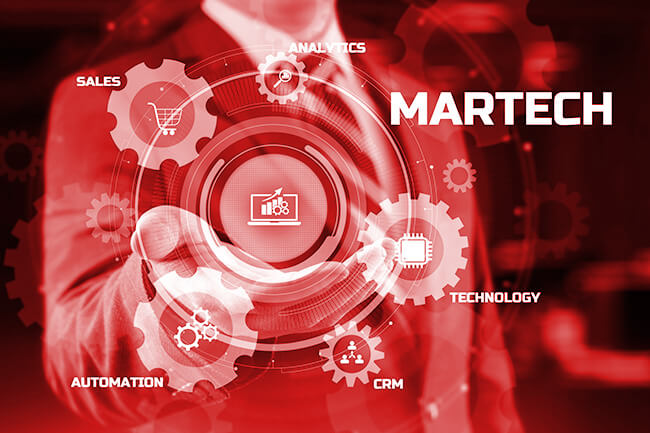A marketing technology stack comprises various software tools utilized by marketers to strategize, implement, and assess their marketing campaigns. This stack encompasses customer relationship management systems, automation tools, analytics platforms, email marketing software, and other essential components.
The stack is crucial because it streamlines marketing processes, enables data-driven decision-making, enhances personalization, and improves collaboration among marketing teams. It also helps businesses stay competitive, track return on investment, and scale their marketing efforts efficiently.
In essence, a well-optimized marketing technology stack empowers marketers to connect with their target audiences effectively and achieve better results in the digital age.
What Is Marketing Technology (Martech)?
Marketing Technology (MarTech) is like having a box of magic tools that helps marketers do their jobs better. It’s a bunch of software and technology that lets them plan, run, and measure their marketing campaigns.
From managing customer relationships to automating tasks and analyzing data, MarTech is the secret sauce that makes marketing more efficient and successful. So, imagine having a supercharged toolkit that makes your marketing awesome – that’s MarTech!
What Is A Martech Stack?
A Martech stack, short for marketing technology stack, is a collection of specialized software tools that empower marketers to plan, execute, and measure their marketing efforts effectively. It includes diverse applications like CRM systems for customer data management, automation tools for streamlining tasks, analytics platforms for data insights, and email marketing software, among others. This integrated toolbox provides marketers with the necessary resources to optimize campaigns, analyze performance, and drive meaningful results.
Key Components Of A Martech Stack
A Martech stack typically consists of the following key components:
- Customer Relationship Management(CRM) System: To manage customer data, interactions, and leads, enabling personalized marketing efforts.
- Marketing Automation: Tools that automate repetitive tasks like email marketing, lead nurturing, and social media posting.
- Analytics and Data Tools: For tracking and analyzing campaign performance, customer behavior, and ROI.
- Content Management System (CMS): To create, manage, and publish content on websites and digital channels. An additional element to include when it comes to your content is SEO services to ensure that it is discoverable.
- Email Marketing Software: Specifically for managing email campaigns, segmentation, and performance tracking.
- Social Media Management Platforms: To schedule posts, monitor brand mentions, and analyze social media metrics.
- Advertising Platforms: For managing online advertising campaigns across various channels.
- Search Engine Optimization (SEO) Tools: To optimize websites for search engines and track SEO performance.
- Data Analytics and Business Intelligence: Advanced analytics tools for data-driven decision making.
How To Build Your Marketing Tech Stack: Step-By-Step
Here’s a simple step-by-step guide to building your marketing tech stack:
- Know Your Needs: Understand your marketing goals and tasks you want to improve.
- Research Tools: Look for marketing software that fits your needs and budget.
- Start with Essentials: Begin with key tools like CRM, automation, and analytics.
- Test Before Committing: Try free trials or demos to see if the software works for you.
- Scale and Adapt: Choose tools that can grow with your business and adapt to changes.
- Train Your Team: Ensure your team knows how to use the tools effectively.
- Monitor and Improve: Keep track of performance and make adjustments as needed.
- Stay Updated: Stay informed about new trends and technologies in marketing.
Essential Tips For Building Your Martech Stack
Here are simple tips for building your Martech stack:
- Set Clear Goals: Define your marketing objectives and challenges.
- Start Small: Begin with a few essential tools and expand gradually.
- Choose Integration-Friendly Tools: Pick tools that work well together.
- Prioritize User-Friendly Interfaces: Opt for easy-to-use tools.
- Ensure Data Security: Keep data protection in mind.
- Think Scalability: Select tools that can grow with your business.
- Get Support and Training: Look for good customer support and training options.
- Foster Collaboration: Involve all relevant teams in the decision-making process.
- Analyze Costs and ROI: Evaluate the cost and benefits of each tool.
- Stay Updated: Keep abreast of new marketing technology trends.
Essential Martech Tool Categories To Include In Your Stack
When building your Martech stack, make sure to include these essential tool categories:
- Customer Relationship Management (CRM): Manage customer data and interactions.
- Marketing Automation: Automate repetitive tasks like email marketing and social media.
- Analytics and Data Tools: Track campaign performance and customer behavior.
- Content Management System (CMS): Create and manage content on websites and channels.
- Email Marketing Software: Manage email campaigns and track performance.
- Social Media Management Platforms: Schedule posts and monitor social media engagement.
- Advertising Platforms: Manage online advertising campaigns.
- Search Engine Optimization (SEO) Tools: Optimize website visibility on search engines.
- Data Analytics and Business Intelligence: Gain valuable insights from data.
- Customer Experience and Personalization: Improve customer experience and deliver targeted content.
Top Marketing Tech Stack
A top marketing tech stack is a set of important tools that help make marketing better and keep customers interested. These tools include:
- Customer Relationship Management (CRM) system: It helps manage customer information and interactions, making it easier to build good relationships with customers.
- Marketing Automation Platform: This tool automates repetitive tasks and helps nurture potential customers, making it easier to convert them into loyal ones.
- Email Marketing Software: It lets you create and send emails to customers, and also tracks how well your email campaigns are doing.
Also, there’s a Content Management System (CMS) to help you manage your website content. And, Analytics and Reporting Tools give you information about how well your marketing is doing and the return on your investment.
Social Media Management Tools enable effective social media marketing, while Search Engine Optimization (SEO) Tools improve organic search visibility. Paid advertising campaigns are facilitated by Advertising Platforms like Google Ads or Facebook Ads, and A/B Testing Tools help optimize marketing assets.
Data Analytics and Business Intelligence Tools provide actionable insights, and Customer Experience (CX) and Personalization Tools create personalized experiences. Integrating the CRM with other marketing tools is made possible with CRM Integration Tools. While technology continues to evolve, these core marketing tools serve as a strong foundation for successful marketing strategies and campaigns.
Our Top Tech Stack Tools
- ActiveCampaign: Streamline and personalize your sales funnel with ActiveCampaign’s automated follow-up and outreach, optimizing conversions by categorizing stages and tracking consumer preferences.
- Heap Analytics: Simplify data analysis with Heap Analytics’ no-code approach, automatically collecting data and enabling easy creation of reports, heatmaps, and funnel analyses for insightful marketing decisions.
- Getsitecontrol: Elevate audience engagement through Getsitecontrol’s Conversion Rate Optimization (CRO) tool, utilizing pop-ups and sticky bars to extend visitor stay, gather leads, and drive them through the sales funnel.
- WotNot: Achieve automated demand generation and customer engagement with WotNot’s no-code bot builder, seamlessly capturing and converting visitors, integrating data, and offering actionable insights.
- FeedHive: Enhance social media engagement with FeedHive’s content scheduling and AI-generated posts, saving time while maintaining a consistent online presence and leveraging post templates.
- HotJar: Gain profound product experience insights through HotJar’s heatmaps, session recordings, surveys, and funnel tracking, enabling a comprehensive understanding of user behavior and optimization opportunities.
- Calendly: Simplify appointment scheduling with Calendly, enabling effortless booking of meetings, interviews, and demos, boosting engagement and streamlining lead qualification.
- Salesforce: Unify customer data and manage interactions with Salesforce’s cloud-based CRM, offering customization, collaboration, and data-driven insights for effective marketing campaigns.
- Slack: Foster efficient teamwork and communication with Slack’s messaging and integration capabilities, connecting marketing tools and facilitating real-time updates, discussions, and collaboration.
- Ahrefs: Boost website visibility and traffic through Ahrefs’ comprehensive SEO toolkit, aiding keyword research, competitive analysis, and tracking of backlinks and ranking history to optimize online presence.
Conclusion
A well-built marketing tech stack is not just a luxury but a necessity in today’s competitive business landscape. It serves as a powerful toolkit that empowers marketers to unleash their creativity, enhance customer experiences, and achieve remarkable results.
With the integration of diverse tools like CRM, automation, analytics, and more, businesses can streamline marketing operations, make data-driven decisions, and foster meaningful connections with their target audience. Embracing a robust Martech stack enables businesses to stay ahead in the digital age, unlocking unprecedented opportunities for growth, innovation, and success.
As technology continues to shape the future of marketing, investing in a comprehensive Martech stack becomes an essential cornerstone for any organization striving to thrive and flourish in the ever-evolving marketing landscape.





Tell us your thoughts in the comments